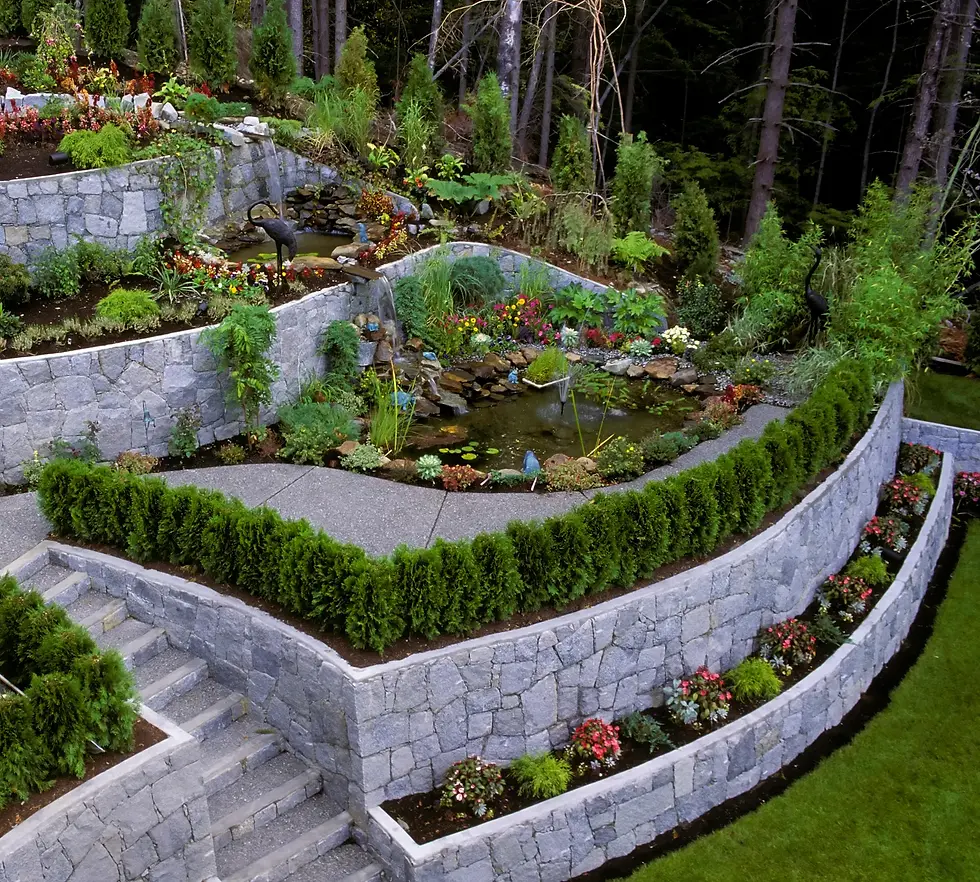Is a Block Retaining Wall Cheaper Than Concrete?
- Solid Ground Outdoor
- Feb 17
- 3 min read
TLDR;
Yes, a block retaining wall is generally cheaper upfront than a poured concrete wall, mainly due to lower material costs and simpler installation. However, long-term maintenance, durability, and labor expenses can affect the overall cost-effectiveness of each option.
When planning a retaining wall, one of the biggest concerns is cost. Homeowners and contractors alike often ask: Is a block retaining wall cheaper than concrete? The answer depends on factors such as materials, labor, longevity, and maintenance. In this guide, we’ll break down the costs, pros, and cons of both options to help you make the best choice for your project.
What Are Retaining Walls?

Retaining walls serve a crucial role in landscaping and construction, helping to prevent soil erosion, support sloped terrain, and create aesthetically pleasing outdoor spaces. They are commonly used in both residential and commercial projects, making material choice a significant factor in cost and durability.
Types of Retaining Walls
Block Retaining Walls (CMU - Concrete Masonry Units): Built using stacked concrete blocks, often reinforced with rebar and mortar.
Poured Concrete Retaining Walls: Formed by pouring liquid concrete into a mold or frame and allowing it to set into a solid structure.
Each type of retaining wall has its own strengths, costs, and aesthetic appeal. If you're exploring different materials, check out the Differences Between Boulder, Wood, and Block Retaining Walls to find the best fit for your project.
Understanding the cost and benefits of each will help determine which option is right for your needs.
Cost Comparison: Block Retaining Wall vs. Poured Concrete

Material Costs (Per Square Foot)
Concrete Block Retaining Walls: $10 – $20 per sq ft
Poured Concrete Retaining Walls: $15 – $30 per sq ft
Block walls tend to be more cost-effective when considering materials alone. However, material pricing fluctuates based on block type, finish, and local availability.
Labor Costs
Block Retaining Walls: Higher labor costs due to the stacking and mortar process, but easier for DIY installation.
Poured Concrete Walls: Lower labor costs per hour but require specialized skills and equipment for formwork and pouring.
While poured concrete walls may require fewer labor hours, the process involves more preparation and finishing work, potentially offsetting the cost difference.
Long-Term Costs & Maintenance
Block Walls: More susceptible to shifting and settling over time, requiring occasional reinforcement.
Poured Concrete Walls: Stronger but prone to cracking, which can be expensive to repair.
A block retaining wall may be cheaper upfront, but maintenance costs can add up over time.
Strength & Durability Comparison

Load-Bearing Capacity
Poured concrete walls are structurally stronger and better suited for high load-bearing situations. Block walls can be reinforced but may require additional materials for stability.
Structural Integrity
Block walls rely on interlocking designs and mortar joints, making them flexible but more prone to wear. Poured concrete is a solid monolithic structure, reducing the risk of shifting.
Weather Resistance
Block Walls: More vulnerable to water infiltration, leading to potential cracking and erosion.
Poured Concrete: Resistant to moisture damage but may develop surface cracks over time.
Installation Process & Complexity

How Block Retaining Walls Are Built
Excavate and Level the Base – A compacted gravel foundation is necessary for drainage.
Stack the Blocks – Use mortar or interlocking techniques.
Reinforcement – Additional rebar and backfill may be needed for higher walls.
How Poured Concrete Walls Are Built
Formwork Construction – Wood or metal molds create the desired shape.
Pour and Cure the Concrete – Requires precision and patience.
Finishing Touches – May require additional waterproofing or sealing.
Poured concrete walls require more preparation and specialized labor, making them less DIY-friendly compared to block walls.
Aesthetic & Design Flexibility

Block Walls: Available in various textures, colors, and styles to match landscape aesthetics.
Poured Concrete Walls: Offers a smooth, modern finish but requires additional treatments for decorative appeal.
Environmental Impact & Sustainability

Block Walls: Often made with recycled materials, reducing environmental footprint.
Poured Concrete: More carbon-intensive due to high cement usage.
For eco-conscious builders, block walls may be a more sustainable option.
FAQs: Answering Common User Questions
Which retaining wall lasts longer, block or poured concrete?
Poured concrete generally lasts longer with less maintenance, but block walls can be reinforced for added longevity.
Can I build a block retaining wall myself?
Yes, block walls are more DIY-friendly, but proper drainage and reinforcement are crucial.
What is the cheapest retaining wall option?
Concrete block walls are typically the most cost-effective choice upfront, though maintenance costs should be considered.
Conclusion
A block retaining wall is generally the more budget-friendly option, but poured concrete offers superior strength and durability. If cost is the primary concern, block walls are a good choice. However, for long-term stability and minimal maintenance, poured concrete may be the better investment.
If you're considering a retaining wall for your property, Solid Ground Outdoor provides expert consultation and installation services. Contact us today for a personalized quote!





Comments